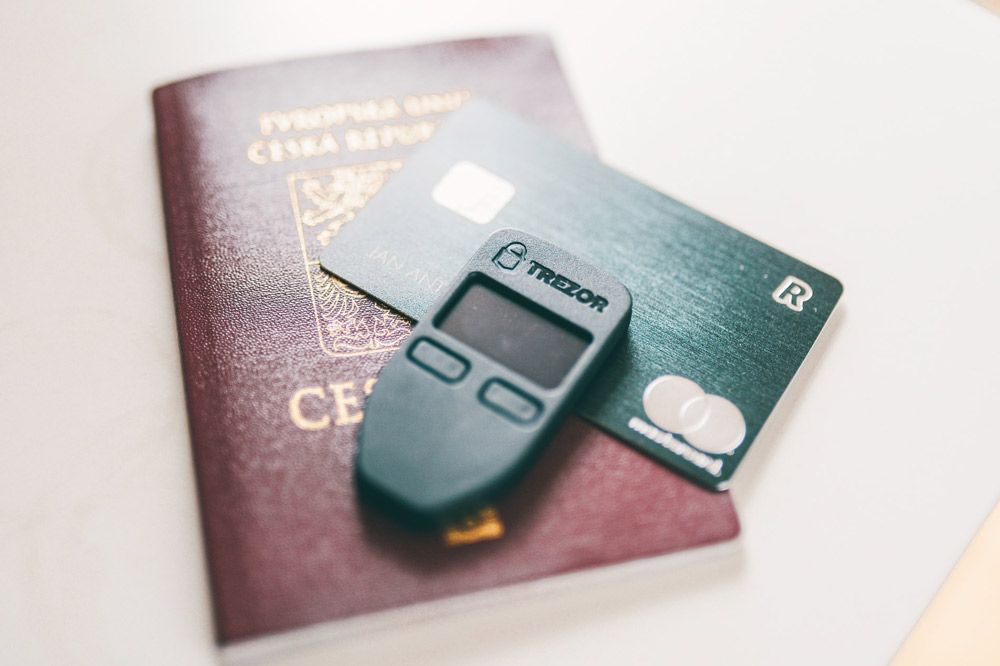DAI is a decentralized stablecoin based on the Ethereum blockchain that was developed by MakerDAO (MKR).
It’s a new type of cryptocurrency that serves to diminish the wild price swings that make bitcoin impractical for commerce. The coins’ value is based on more stable core assets that are usually found in traditional currencies or commodities.
DAI Background
DAI stablecoin uses Ethereum, a digital currency, to maintain its consistent value and is essential to MakerDAO’s lending system. The decentralized stablecoin isn’t backed by cash reserves, but instead is value controlled by DeFi protocol MakerDAO. Whenever a loan is taken through the MakerDAO platform, DAI stablecoin is created, and this is the currency that users borrow and pay-back their loan with.
Once DAI is created, it operates simply as a stable Ethereum token. It serves as a convenient and secure method to pay for things and can easily be transferred between Ethereum wallets.
One DAI is equivalent to one US dollar and will maintain that consistent ratio until the token is taken out of circulation. DAI uses smart contracts that are block-chain based commands with inherent terms set in code. This ensures its stable value while offering transparency and decentralization to its users.
Similar to Bitcoin, DAI aims to drive a digital economy where users don’t need the services of banks and financial institutions to transact directly with other users.
What Is Stablecoin?

Stablecoin is a cryptocurrency whose value is attached to more predictable assets like fiat currencies, collaterals, other cryptocurrencies, selected goods in a consumer price index, precious metals, or oil. They act as vital tokens in the DeFi ecosystem.
BC. Game foresaw DeFi’s potential as early as 2019 and integrated DAI. Recently BC.Game introduced the decentralized oracle Chainlink into the platform to provide players with more trendy choices.
Some stablecoin projects attempt to manipulate a consistent value using algorithms. The overarching objective of a stablecoin is to generate a crypto asset whose value isn’t disposed to extreme volatility.
Besides DAI, some of the most popular stablecoins include:
- Tether (USDT)
- TrueUSD (TUSD)
- Paxos Standard Token (PAX)
- USD Coin (USDC)
- Gemini Dollar (GUSD)
Stablecoins play a pivotal role in the ecosystem of cryptocurrencies. During volatile market periods, they offer a stable store of value. This stable cryptocurrency can be used for fast and undisputable global remittances and payments. They can also be used to send transactions that are uncensored to any other user that has a wallet and an internet connection. Moreover, users can send large amounts of money securely and more cost-effectively.
Categories Of Stablecoins
Stablecoins are grouped into four categories:
1. Fiat-Collateralized
Fiat-collateralized stablecoins are the most common type. Almost all of them depend on centralized institutions and can be centralized.
Popular fiat-collateralized stablecoins include Tether (USDT), TrueUSD (TUSD) and USD Coin (USDC).
2. Crypto-Collateralized
Crypto-collateralized stablecoins are not reliant on traditional finance infrastructure and make use of crypto assets as collateral. Together with them being less centralized and transparent, they are also more complex by design.
Popular Crypto-collateralized stablecoins include Dai (DAI) & Maker (MKR); Havven (HAV) & nUSD, and Bitshares (BTS) BitUSD.
3. Algorithmic Non-Collateralized
Algorithmic non-collateralized stablecoins seek to achieve stability by using software-based economic models. Although they are decentralized by nature, they can be highly risky and complex, since they need continuous growth to maintain balance.
Algorithmic non-collateralized stablecoins include Basis, Kowala, Carbon, and Fragments.
4. Hybrid Stablecoins
Hybrid stablecoins are dependent on a blend of the above-listed approaches and include Reserve, Saga, and Aurora-Boreal.
DAI stablecoin is grouped under the crypto-collateralized stablecoin category that uses Maker (MKR) and Ether (ETH) to maintain a stable value.
What Is Maker (MKR)?
Maker (MKR) is a decentralized autonomous organization (DAO) that is built on an Ethereum blockchain. Furthermore, it is a cryptocurrency and a governance token that is in charge of two tokens, Makercoin (MKR) and Dai (DAI).
Both MKR and DAI are issued on the Ethereum according to ERC-20 standards.
Maker (MKR) has ambitions to develop a line of stable decentralized digital assets that would be linked to multiple currencies, gold, and other instruments.
MKR holders are responsible for Maker system’s risk management, its business logic, the payment of Dai loans, and/or setting the debt ratio.
Every Maker holder can vote on essential decisions concerning the platform and issuance of DAI. This includes risk parameters, target rates, price feed sensitivity, and global settlement decisions, amongst others. If any user needs to request a loan in Dai, the Maker coin is used to pay the stability fee.
MKR coins are not capable of being mined and are typically burned in the settling process.
How Is DAI Created?
Since DAI is a crypto-collateralized stablecoin, it is collateralized with Ether. Any holder of Ether can create DAI using the MakerDAO app.
Users must first send their Ether (ETH) to a collateralized debt position (CDP). Once they have done that, they will receive a portion of DAI. A CDP is a smart contract that operates on the blockchain and regulates the issuance and redemption of DAI.
Once users receive DAI in return for their ETH, the only way for them to get their Ether back is to repay the borrowed DAI.
Typically, the DAI issuance process that users would experience is as follows:
- A user deposits ETH ($200 for example)
- The user will then receive 100 DAI worth $100 with a collateralization ratio of 2:1
- They then proceed to withdraw DAI and use it as required
- In the event that the user desires to switch DAI back to ETH, they need to repurchase it with the same 100 DAI, together with added interest
- The user then pays back the DAI plus the accrued interest. These interest fees are then sent directly to MKR token holders for maintaining the system.
As is evident above, DAI is primarily a loan taken against Ethereum. By using MakerDAO, Ether users can request for DAI loans against their Ether holdings.
This process starts with converting a user’s ETH holdings to an ERC-20 token called Wrapped Ethereum (WETH). Upon completing this process, WETH joins the pool of Ethereum that is then used as collateral for all issued DAI tokens.
The pool is called Pooled ETH (PETH), which is locked to create a Collateralized Debt Position (CDP). Users subsequently receive DAI tokens, which they are free to use.
The CPD debt ratio is inclined to increase when DAI is created until it reaches a specific limit. When this limit has been reached, no additional DAI can be withdrawn against the CPD.
How Does DAI Work?
There are various methods in place that ensure DAI improved stability so that the stablecoin stays within ratio to the US dollar. MakerDAO created a smart contract platform on the Ethereum blockchain that supports and stabilizes DAI through a succession of dynamic feedback systems called CDP smart contracts. These CDPs are also helpful in facilitating a streamlined decentralized margin trading platform.
With a CDP, users can deposit any number of assets into a smart contract as collateral for a loan. Once the CDP possesses the assets deposited by a user, the user can then convert the equivalent USD value in DAI that they wish to borrow.
Users have the freedom to do anything that they wish with the coin, just like any other form of cryptocurrency. DAI is subsequently destroyed once the loan has been paid back.
Any user can use or build with DAI without the need to seek permission as it is a token on Ethereum. The coin operates as a building block that can easily be integrated into any Dapp that requires a stable asset or payment system. Additionally, any developer can wrap DAI in various smart contracts that can be modified for multiple uses.
DAI stablecoin is typically used as a stable hedge or counterweight against the unpredictability of more common crypto-assets such as Ethereum or Bitcoin. DAI is especially popular with investors and/or traders that believe that markets are going down.
While many stablecoins are trusted because their value is dependent on central bank currencies, DAI has earned a solid reputation for reliability, as the Ethereum that is locked in the smart contracts always exceeds the value of the currency in circulation at any given time.
How Does DAI Maintain Its Value?
The price of DAI is constantly kept in check through an intricate system of smart contracts that automatically execute themselves. If the price of DAI fluctuates too far from one dollar, Maker (MKR) tokens are then burned or created to stabilize the price of DAI. This is possible through MakerDAO’s algorithms that automatically manage the currency price to keep it steady.
DAI makes use of game theory and cautiously balances economic incentives to incessantly sustain the value of one US dollar. When a single token drops below one US dollar, the system provides incentives to users to increase the price. And when one DAI is valued at more than one US dollar, the incentives swing the opposite way around.
Under either of these circumstances, rational users can make money due to the price swings.
The further apart DAI deviates from the mean of one US dollar, the more attractive the incentives offered for users to fetch the price back to one US dollar.
Moreover, the stablecoins are always over-collateralized. Essentially, this means that instead of backing coins at a 1:1 ratio with their underlying assets, the ratio is always programmed to more than 1:1.
If, for example, Ether is worth one hundred dollars and the collateralization ratio is 150%, users can seamlessly create 66 DAI stablecoin.
Since DAI is an Ethereum ERC20 token, it is capable of being stored in ERC-20 compliant wallets like MyEtherWallet, Atomic, Exodus, Jaxx, Mist, Metamask, amongst others.
For an added measure of security, users can also make use of hardware wallets such as Ledger or Trezor.

Benefits Of The Stablecoin
Complete Financial Independence
Traditional financial systems, banks, and other financial institutes require lots of information from potential users, such as personal data, proof of good credit, and minimum deposit amounts. These requirements can be a hindrance and contribute to the global underbanked population.
DAI stablecoin, however, permits anyone access to financial services that provide unmatched financial freedom without restrictions.
Self-Sovereign Money Generation
Although many users buy the currency on numerous exchanges to use as they please, others turn to the Maker Protocol to generate DAI as opposed to purchasing it.
Users simply lock a surplus of collateral in Maker Vaults, creating DAI based on the amount of collateral they choose to lock. Many business owners also create DAI to generate operational capital by hedging crypto’s characteristic volatility while keeping their funds in the blockchain space.
Savings
Holders of the DAI stablecoin can earn a Dai Savings Rate (DSR) on the coin that they hold by locking it into a special smart contract. This is beneficial as there are no fees involved, no geographic constraints, and no minimum deposit is required to earn the DSR. Additionally, all or any portion of amount can be withdrawn at any time.
Stability Amidst Volatility
The DAI stablecoin offers stability in the volatile world of cryptocurrency. The currencyDai is attached to the US Dollar and supported by a surplus of collateral locked in Maker Vaults. When the market is highly volatile, DAI enables users to store their value without leaving the crypto space.
Low-Cost Remittance, Convenient and Fast
DAI can be used for repayment of debt, cross-border transactions, and payment for goods and services. Sending money across borders using traditional financial services can prove to be expensive and time-consuming. Coin users, however, can transfer peer-to-peer around the world within seconds and at a fraction of the cost.
24/7 Service
Conventional financial services companies usually operate on traditional business hours. DAI, however, is available to users 24/7 as it is decentralized and built on the blockchain.
Convenient Exchange
DAI can be easily exchanged for fiat currency through multiple regulated platforms such as Coinbase and Wyre.
Transparency
The decentralized Maker Protocol enables users to have insight into how DAI works. Moreover, Blockchain technology has its own inherent checks and balances, as all transactions are shared on a public ledger for public consumption.
Additionally, technically-minded users can review the audited and verified smart contracts to evaluate how these financial technologies work.













